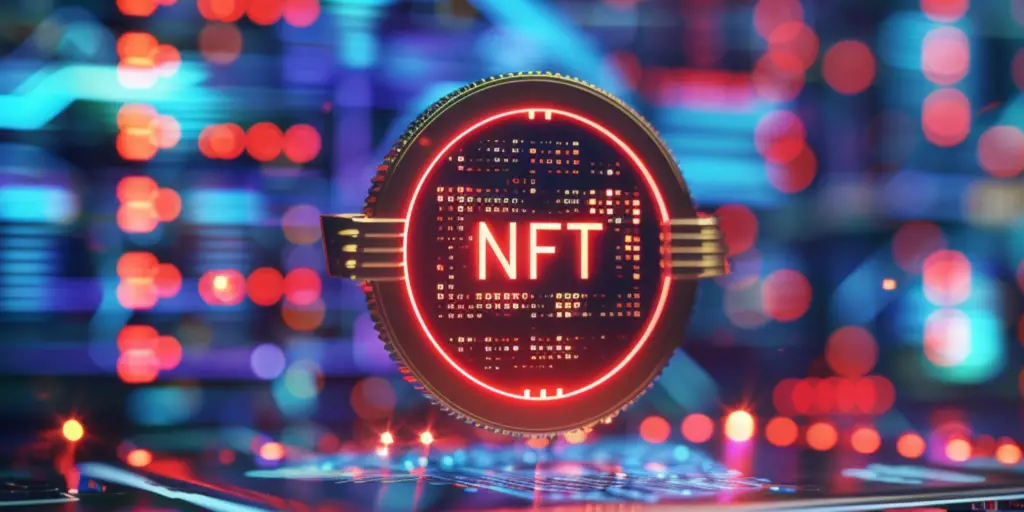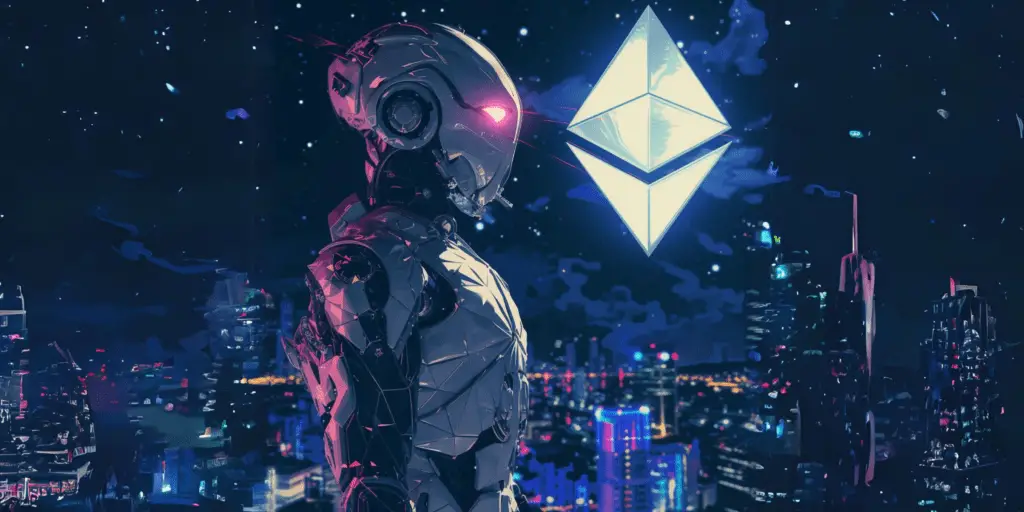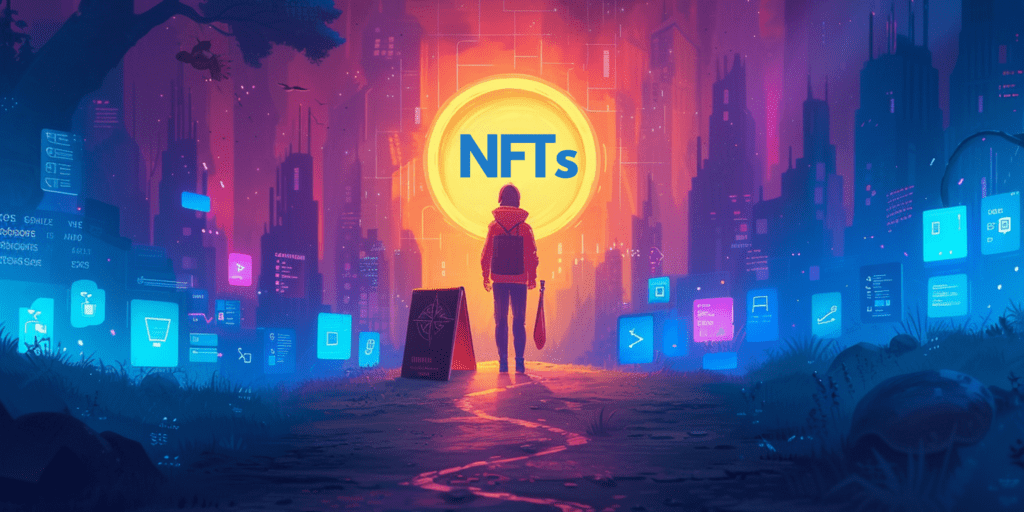In recent years, the digital world has witnessed the meteoric rise of a revolutionary concept that has transformed how we perceive ownership, creativity, and value in the virtual space: Non-Fungible Tokens, or NFTs. These unique digital assets, built on blockchain technology, offer a new way to buy, sell, and trade digital goods with a level of security and authenticity previously unseen.
Unlike traditional cryptocurrencies or digital assets, which are interchangeable and identical, Non-Fungible Token stand out for their uniqueness and indivisibility, representing a wide array of digital items—from artwork and music to virtual real estate and beyond.
But what exactly are Non-Fungible Token and why have they garnered such widespread attention and debate? How do they function, and what sets them apart from other forms of digital assets.
As we navigate through the burgeoning landscape of digital innovation, it’s essential to explore not only the current uses and features of NFTs but also to ponder their future potential and the challenges they may face.
This article aims to demystify NFTs, delving into their core features, the diverse uses they have found across various sectors and the promising yet uncertain future they hold. Whether you’re a digital artist, a collector, an investor, or simply curious about the future of digital ownership, understanding NFTs is crucial in grasping the evolving dynamics of the digital age.
Understanding NFTs
Non-Fungible Token is a digital asset that represents real-world objects like art, music, in-game items, and videos. They are bought, sold, and traded online, frequently with cryptocurrency. They are encoded with the same underlying software as many cryptos.
The key characteristic that distinguishes NFTs from cryptocurrencies is their non-fungibility. Every NFT has a digital signature that makes it impossible for NFTs to be exchanged on a like-for-like basis. This contrasts sharply with fungible items, such as bitcoins or dollars, which are identical to one another and can be used as a medium for commercial transactions.
Non-Fungible Token are built on blockchain technology, a decentralized ledger that records all transactions across a network of computers. This technology ensures the authenticity and ownership of each NFT, making it secure and resistant to tampering.
The most common blockchain on which NFTs are issued is Ethereum. Still, other blockchains like Binance Smart Chain, Flow by Dapper Labs, and Tezos also support NFTs.
Digital ArtOne of the most popular uses of NFTs, allowing artists to sell their work digitally to a global audience. CollectiblesDigital versions of collectible items, such as trading cards and figurines. Gaming ItemsUnique in-game items, characters, or skins that players can buy, sell, or trade.
Music and VideosMusicians and filmmakers can sell their works as NFTs, providing a new revenue stream and a way to connect with fans. Virtual Real Estate and Assets Ownership of virtual land and assets in digital worlds and metaverses.
What sets Non-Fungible Token apart is their ability to verify the uniqueness and ownership of digital items. Through the blockchain, an NFTs can confirm who owns a digital asset and the history of its ownership.
This aspect is crucial for the digital art market, where replication and distribution are as easy as copying and pasting, as it allows creators to monetize their digital works while providing buyers with proof of ownership and authenticity.
Non-Fungible Token is foundational to appreciating the broader implications they have on digital ownership, creativity, and the economy. As we delve deeper into the era of digitalization, NFTs emerge as pivotal players in redefining value, ownership, and the exchange of digital goods.
Through their unique blend of technology and creativity, NFTs are not just transforming the art world. Still, they are also setting the stage for new forms of digital assets and interactions.

Key Features of NFTs
Unlike cryptocurrencies, which can be divided into smaller units NFTs are indivisible. They exist as whole items and cannot be owned fractionally. This indivisibility ensures that each NFT remains a unique, single asset, maintaining its value and integrity.
One of the most compelling features of NFTs is their built-in scarcity. Creators can limit the number of identical NFTs or issue them as one-of-a-kind assets, making them rare by design.
This rarity is verifiable on the blockchain, where each NFT’s metadata, including its edition size and unique identifiers, is recorded. The uniqueness and scarcity of NFTs create a sense of exclusivity and drive their value.
Non-Fungible Token utilize blockchain technology to provide irrefutable proof of ownership and a transparent history of an asset’s provenance. When an NFT is created or transferred, the transaction is recorded on the blockchain, creating an immutable history of its ownership.
This feature addresses common concerns in the art market and beyond about authenticity and originality, offering a digital solution to age-old problems.
Non-Fungible Token are designed to be interoperable across different platforms and ecosystems, thanks to the standardized protocols on which they’re built, such as ERC-721 and ERC-1155 on the Ethereum blockchain. This means that NFTs can be displayed, traded, and utilized in various applications, games, and marketplaces, enhancing their utility and appeal.
Non-Fungible Token grant digital ownership in a way that wasn’t possible before their advent. Owners of NFTs have control over their digital assets in a manner akin to physical ownership. They can display, sell, or license their assets as they see fit, all while maintaining security and proof of authenticity through the blockchain.
Like other blockchain-based assets, NFTs can include smart contracts that enable programmable features, such as royalties for creators on secondary sales, usage rights, and more. This programmability opens up a myriad of possibilities for creators to monetize their work and for owners to engage with their digital assets in dynamic ways.
Uses of NFTs
One of the most prominent uses of NFTs is in the digital art world, where artists can tokenize their works to sell as unique digital items. This has opened up new revenue streams and market opportunities for artists and collectors alike. Beyond art, NFTs are also widely used for digital collectables, such as trading cards and virtual pets, allowing for the collection, display, and trading of these items in digital spaces.
In the gaming industry, NFTs have revolutionized the concept of in-game assets. Players can now own, buy, sell, and trade virtual goods as NFTs, ranging from character skins and weapons to entire virtual landscapes. This not only enhances the gaming experience by providing actual ownership of in-game items but also creates a new economy within and across games.
Musicians and creators in the entertainment sector are increasingly using NFTs to monetize their content directly to fans. By tokenizing music tracks, albums, or exclusive experiences, artists can sell their work as unique digital assets, offering a new form of engagement with their audience. This model provides artists with more control over their work and opens up innovative ways for fan interaction.
Non-Fungible Token are making their mark in the real estate market, both virtual and physical. In virtual worlds, such as metaverses, users can buy, sell, or rent virtual land and properties as NFTs. This virtual real estate market mimics the physical one, with the added benefits of blockchain’s security and transparency. There’s also growing interest in tokenizing physical real estate, making property ownership more accessible and divisible.
Non-Fungible Token offer solutions for digital identity verification and the certification of authenticity for various items. By tokenizing credentials, certificates, and degrees, individuals can prove their qualifications and achievements in a secure, easily verifiable way. Similarly, luxury goods and collectables can be accompanied by NFTs to prove their authenticity and ownership history.
Non-Fungible Token provide a powerful tool for content creators to monetize their work and assert their rights. Through smart contracts, creators can receive royalties automatically every time their NFT is resold, ensuring ongoing revenue from their creations. This feature empowers creators and contributes to a more sustainable ecosystem for digital content production.

Benefits and Challenges
Non-Fungible Token have transformed the digital art scene by enabling artists and creators to monetize their work directly. By tokenizing digital art, creators can sell their pieces as unique, verified assets, ensuring they receive fair compensation through initial sales and potentially benefiting from royalties on secondary sales.
The blockchain technology underlying NFTs provides a transparent and immutable record of ownership and transaction history. This feature is invaluable for verifying the provenance of unique digital items, effectively combating issues of fraud and duplication that plague various sectors, from art to collectables.
Non-Fungible Token open up new markets for digital and physical assets by creating a global platform where they can be bought and sold. This accessibility enables creators, gamers, musicians, and other professionals to reach wider audiences and tap into novel revenue streams.
In the entertainment industry, especially, NFTs offer innovative ways to engage with audiences. Artists can offer exclusive content, early access, or unique experiences as NFTs, fostering a deeper connection with their fan base and offering fans a stake in their favourite artists’ success.
The most significant criticism of NFTs relates to their environmental impact, as the blockchain networks they operate on, particularly Ethereum, require substantial energy use. The proof-of-work (PoW) mechanism, though being phased out by some platforms in favour of more energy-efficient models, has raised concerns about the carbon footprint of minting and trading NFTs.
Non-Fungible Token market is known for its high volatility, with the value of digital assets fluctuating wildly. This unpredictability can pose risks for investors and creators alike, making it a speculative market for those looking to profit from NFT trading.
The ease of creating and trading NFTs has led to challenges around copyright and intellectual property rights. There have been instances where artists’ work was tokenized and sold without their permission, raising questions about copyright enforcement and ownership in the digital space.
Non-Fungible Token offer new opportunities for creators, the market’s complexity and the cost of entry can be barriers for many. The technical knowledge required to create, buy, and sell NFTs, along with the high transaction fees on some platforms, may exclude less tech-savvy individuals and those with fewer financial resources.
The Future of NFTs
As virtual reality and augmented reality technologies mature, the integration of NFTs with the metaverse—a collective virtual shared space—is expected to deepen. NFTs will likely play a crucial role in these environments, serving as the backbone for transactions involving virtual real estate, digital goods, and identity verification within these immersive digital worlds.
Non-Fungible Token are beginning to make inroads into traditional sectors such as real estate, finance, and legal documents. Tokenizing physical assets and essential documents as NFTs can streamline transactions, enhance security, and ensure verifiability. This suggests a future where NFTs bridge digital and physical realms more seamlessly.
As the NFT market matures, we can anticipate further developments in NFT standards and increased interoperability between different blockchains and platforms. This will facilitate more effortless movement and utilization of NFTs across various ecosystems, enhancing their utility and value.
Non-Fungible Token are set to play a significant role in the expansion of decentralized finance, with possibilities ranging from using NFTs as collateral for loans to tokenizing financial instruments. This intersection could introduce more personalized and flexible financial products.
The use of NFTs for digital identity verification and the tokenization of personal credentials (e.g., academic degrees and certificates) is an area ripe for growth. Such applications could revolutionize how personal identity and achievements are verified online, offering a secure, immutable, and easily transferable method of managing digital identities.
For content creators, NFTs offer a new model for copyright and intellectual property management, allowing for more direct control over distribution and monetization. This could lead to innovative content creation and consumption models, where creators have greater autonomy and fans enjoy more interactive and exclusive experiences.
Addressing environmental concerns associated with blockchain technology is crucial for the long-term viability of NFTs.The development of clear regulations and legal frameworks will be vital in addressing issues of copyright, ownership, and the use of NFTs in financial markets.
Ensuring more excellent stability and reducing speculative volatility in the NFT market will be necessary for attracting more widespread and sustained interest.

Final Thoughts
The exploration of Non-Fungible Tokens rom their inception to their current state and potential future highlights a transformative journey within the digital landscape. NFTs have emerged as a groundbreaking innovation, reshaping notions of digital ownership, creativity, and value exchange.
Their unique characteristics—indivisibility, rarity, provenance, and interoperability—have unlocked new possibilities for artists, creators, and collectors, providing a platform for authentic digital ownership and the monetization of digital assets.
The diverse applications of NFTs, spanning digital art, gaming, music, virtual real estate, and beyond, underscore their versatility and the broad spectrum of opportunities they present. As the technology matures, the integration of NFTs across various sectors, including traditional industries and decentralized finance, is expected to deepen, further blurring the lines between the digital and physical worlds.
The journey ahead for NFTs is not without its challenges. Concerns regarding environmental impact, market volatility, and legal complexities remain significant hurdles that the ecosystem must navigate.
The future growth and sustainability of NFTs will depend mainly on addressing these challenges, fostering innovation, and developing a regulatory framework that supports the secure, equitable, and efficient use of NFTs.
As we stand at the cusp of this digital revolution, it is clear that NFTs have not only catalyzed a new wave of digital creativity but also have the potential to fundamentally alter the way we interact with digital content, own digital assets, and perceive value in the digital age. The evolution of NFTs will undoubtedly continue to be a topic of great interest and debate as their impact reaches further into various aspects of our digital and physical lives.


